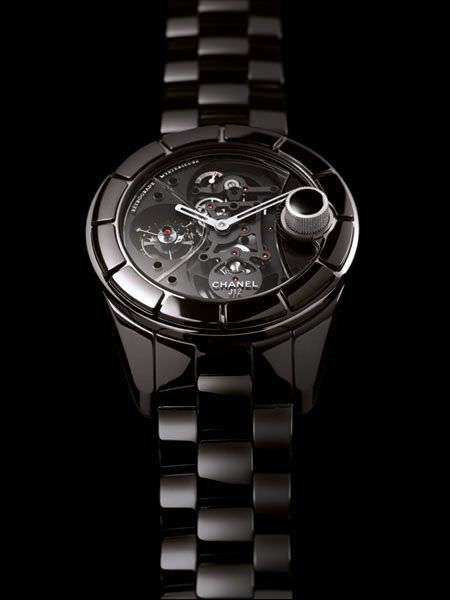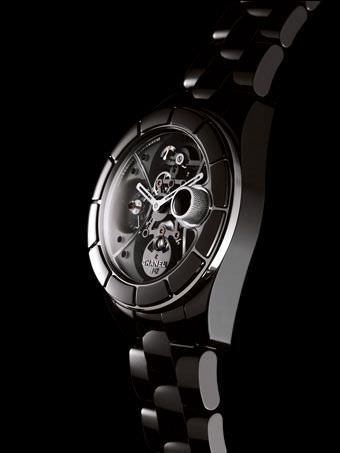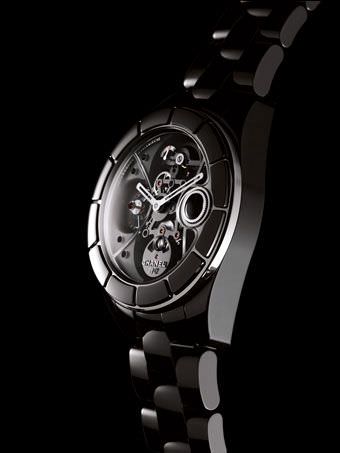To celebrate the J12's tenth anniversary, Chanel is offering a totally new watchmaking complication where aesthetics bow to technical prowess.
Once upon a time there was a round watch. Perfectly round, with no side winding crown to spoil the perfection of this roundness.
In 2000, to create a black watch, perfectly black, Chanel turned to ceramic, the only hightech material capable of achieving this. It was logical for Chanel to put the question of
this round watch, perfectly round with no crown, to one of the most creative teams in fine complications - the Giulio Papi team at APRP (Audemars Piguet Renaud Papi).

An authentic finely-mechanical “complication” was a must if the J12’s tenth anniversary was to be celebrated in fitting style: a way of marking a new stage in Chanel’s career at the heart of fine watchmaking.
The first J12 tourbillon was launched in 2005. This was first in the history of watchmaking - combining a tourbillon with a ceramic watch which also had a ceramic mainplate.
Having acquired a taste for this fine watchmaking, the J12 gave itself a “manufacture” movement in 2008 (calibre 3125, developed in partnership with Audemars Piguet with an innovative ceramic oscillating weight).
2010 - how to devise a fine watchmaking J12 totally in line with the designs of the House of Chanel? How to turn this desire for a perfectly round complicated watch into reality? How to marry Chanel tradition and Swiss micro-mechanical tradition? Guilio Papi, author of some of the most attractive neo-complications in recent years, took up the Chanel challenge.
Immediate response - move the crown! Why not put it on the dial, something never tried before? This immediately raised the problem of the hands - how to make them move round the dial with this crown in the way? This in turn created a further problem - a raised crown on the watch. Why not a vertical retractable crown which would be even more daring?
Just because it's never been tried doesn't mean it can't be done, especially when the Chanel and Giulio Papi teams are working together. It was therefore necessary to invent, in a tourbillon movement, a minute hand capable not just of moving around the dial but also around the crown right on the dial itself.

The only way - the return journey! Move the minute hand forward until it butts up against the crown, then reverse it until it is positioned on the other side of the crown.
In this case, if the hand moves forward then goes into reverse to pick up its travel, what happens to the accuracy of the watch? How can it give the time during this retrograde interval? As the hand can no longer indicate the minutes, figures - digital display - step in in a magnifying aperture located between 5 o'clock and 6 o'clock, an ingenious idea which in no way
disturbs the rate of the hour hand.
The name of this watch is beginning to take on meaning: Rétrograde for the minute hand which reverses its travel for ten minutes during which, at each revolution of the dial, the hand returns to its position under the crown - i.e. between 10 and 20 past each hour, with the minute counted in figures in the magnifying aperture at the bottom of the dial - and Mystérieuse for the mysterious workings of this dual analog and digital display. It is a highly technical and very aesthetically-pleasing watch complication.

Simple to devise but perhaps not so simple to produce! All the more so as this sequentially retrograded hand, duplicated by a digital display of minutes, is an absolute first in watchmaking history. Just like the vertical crown built into the dial, which is deactivated by pressing it flush with the crystal or activated by finger pressure to “release” and manipulate it.
Source: Chanel
www.chanel.com
































